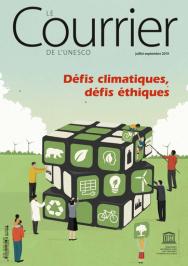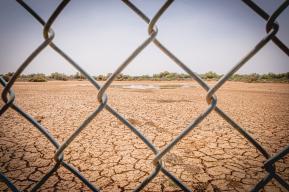مقال
إزالة الكربون: لِنبدأ بالمدن!

يجب على الجهات الفاعلة غير الحكومية، وعلى رأسها البلديات، أن تكون أول من يغرس بذور مجتمع خال من الكربون. ولتفادي كابوس أحوال جوية مضطربة، ينبغي مواصلة التخفيض من انبعاثات الكربون إلى ما أبعد مما تنص عليه اتفاقية باريس. ويقتضي هذا الأمر بذل جهود متضافرة على نطاق عالمي، واتخاذ مبادرات ملموسة من قبيل كهربة وسائل النقل وجعل المساكن خالية من انبعاثات الكربون، فضلاً عن إجراء تحوّل في مجال الطاقة على أوسع نطاق.
بقلم مانويل غوزمان هينيسي
ساد الاعتقاد، قبل نشر التقرير الخاص الصادر عن الهيئة الحكومية الدولية المعنية بتغيّر المناخ في أكتوبر 2018، بأن نقطة التحوّل في ارتفاع متوسط درجة حرارة الأرض تعادل 2 درجة مئوية (تعني نقطة التحول العتبة الحرجة لانتقال المناخ من حالة مستقرة إلى حالة مستقرة أخرى). غير أنه، منذ ذلك الحين، تم إثبات أن نقطة التحول تعادل 1,5 درجة مئوية. ويلاحظ المختصون في العلوم في الهيئة الحكومية الدولية المعنية بتغيّر المناخ أنه، إذا ما تم تجاوز هذا الحد، فإن المجتمع سيتعرض لعواقب وخيمة مثل اختفاء نظم إيكولوجية بأكملها وزوال عدة أنواع حيوية، وذَوبان القمم القطبية، وارتفاع مستوى سطح البحار، وحدوث موجات حرارة وجفاف شديدة، إضافة إلى تزايد الظواهر المناخية القاسية وتَفاقم حدّتها.
لكن تبين أن اتفاق باريس لعام 2015 غير كافٍ لتفادي هذه الكارثة. وقد بين العلماء أن الحد من من ارتفاع درجة حرارة العالم، كي لا يتخطى 1،5 درجة بدلاً من 2 درجة مثلما نص عليه هذا الاتفاق، يجب، بحلول عام 2030، تخفيض انبعاثات ثاني أكسيد الكربون الصافية على الصعيد العالمي بنسبة 45% تقريباً مقارنةً بمستويات عام 2010، وتقليص الانبعاثات لتبلغ «مستوى الصفر» حوالي عام 2050. غير أن الأهداف المحددة للتخفيض من هذه الانبعاثات بموجب اتفاق باريس لا تتعدى في المتوسط نسبة 25%.
ما هو موقف الهيئة الحكومية الدولية المعنية بتغيّر المناخ من هذه المسألة؟ ترى الهيئة أنه يجب «إدخال تغييرات واسعة النطاق وغير مسبوقة»، تخص بشكل أساسي تخفيض انبعاثات الكربون التي نحدِثها. وترتبط مباشرةً انبعاثات ثاني أكسيد الكربون المتراكمة ومتوسط ارتفاع درجات الحرارة بإنتاج واستهلاك الوقود الأحفوري. ويترتب على ذلك احترار عالمي لم نشهد له مثيلاً حتى الآن. واتسمت السنوات الثلاث الأخيرة بكونها أكثر السنوات حرارةً في التاريخ.
بصيص من الأمل
ما الذي يبرر إذن قناعة أهل العلم بأنه من الممكن زرع بذور مجتمع خال من الكربون بحلول عام 2030؟ في رأيهم، من الممكن تحقيق مجتمع خال من انبعاثات الكربون. ولا يتعلق الأمر بمجتمع «بديل» أو بنموذج اجتماعي تجريبي، بل تمثل إزالة الكربون الشرط الجديد لضمان بقاء الحياة على وجه الأرض.
منذ عام 1977، تنشر الوكالة الدولية للطاقة التي تُعد من أوثق المصادر المعترف بها، تقريرا سنويا حول توقعات الطاقة في العالم. ومن الممكن أن نستخلص من التحليلات المنشورة في تلك التقارير أن المجموعات غير الحكومية المؤلفة من مواطنين، وباعِثي مشاريع، وبلديات وجامعات، قامت بالدور الريادي في الجهود الرامية إلى إزالة الكربون. وهناك عدد لا يحصى من المنصات التي تعرض الأنشطة في مجال المناخ التي تقوم بها هذه الجهات الفاعلة الجديدة، والتي ترسم يوميا بشكل واضح تحولا يشق طريقه - أحياناً بسرعة تتجاوز خطى البلاد التي تنتمي إليها - نحو تحقيق الأهداف التي حددتها. وفي ما يلي عرض لهذه القناعات الجديدة التي من شأنها أن تعطينا أملاً جديداً.
أولاً، تجاوز نمو قدرات الطاقة الشمسية الضوئية القائمة في عام 2016 نمو جميع مصادر الطاقة الأخرى. ثم إنه منذ عام 2010، انخفضت تكلفة الإنشاءات الجديدة بنسبة 70% في ما يتعلق بالطاقة الشمسية الضوئية وبنسبة 25% في ما يخص الطاقة الريحية. وبالإضافة إلى ذلك، انخفض سعر البطاريات الضوئية بنسبة 40%. ومن ناحية أخرى، سوف تمثل الطاقات الريحية والشمسية معاً، في الفترة ما بين 2020 و2050، ما نسبته 48% من إجمالي توليد الكهرباء. وقد حدد مجلس أوروبا أهدافاً جديدة يتعين بلوغها في عام 2030 وهي: التخفيض بنسبة 40% من انبعاثات الكربون، وبلوغ نسبة 27% من الطاقات المتجددة في مجمل إنتاج الطاقة، وتحسين نجاعة استخدام الطاقة بنسبة 27%.
مدن تتحرك لصالح المناخ
أعتبر أنه من باب الممكن تحقيق مجتمع خال من الكربون إذا ما تم تركيز الأنشطة الانتقالية المتعلقة بالمناخ على إدارة المدن، وإذا ما تم إنجازها بطريقة مترابطة وتعاونية وعالمية، وذلك خلال الفترة ما بين 2020 و2030.
لماذا نبدأ بالمدن؟ لأن المدن تتسبب في ثلاثة أرباع انبعاثات الغازات الدفيئة وتستهلك ثلثي الطاقة العالمية. كما أن 70% من المدن تعاني بالفعل من الآثار الناجمة عن تغيّر المناخ، فضلاً عن أن جميعها تقريبا معنية بالتهديدات الناجمة عن تغير المناخ. وفي أفق عام 2060، سوف يعيش أكثر من مليار كائن بشري في مناطق حضرية ساحلية قليلة الارتفاع عن سطح البحر ـ أي ما يناهز حسب التوقعات 10% من سكان العالم في ذلك الأفق ـ، والجزء الأكبر منهم في البلدان النامية.
هذه الأرقام التي استقيتها من الخبيرة باهاريه سيادي، المستشارة في مجال السياسات المتعلقة بالمناخ في برنامج الأمم المتحدة الإنمائي، ترسم ملامح هشاشة المدن في مواجهة تغيّر المناخ، كما تدفعنا لإمعَان التفكير في الموضوع.
من الواضح أنه يجب على المدن إعداد خطط عمل في مجال المناخ، بحلول نهاية عام 2020 (أي في الغد القريب!)، ترمي إلى ضمان عدم تجاوز 1،5 درجة مئوية كحد أقصى، والتكيف مع آثار تغيّر المناخ. ومن الممكن بناء خطط العمل هذه حول المحاور الثلاثة التالية: الحد من انبعاثات ثاني أكسيد الكربون، وزيادة القدرة على التكيّف، والتثقيف.
وتشمل عملية الحد من انبعاثات الكربون تحقيق تحول نوعي في نظم النقل، والكفاءة في استخدام الطاقة، والتصرف في النفايات بصفة متكاملة مع تعزيز عملية إعادة التدوير، فضلاً عن تجديد البنى التحتية الحضرية نحو أنماط مستدامة. أما الزيادة في القدرة على التكيف، فلا بد أن تنطلق من التسليم بأن المدن هي نظم معقدة ويجب بالتالي أن تستجيب لآثار تغيّر المناخ بطريقة معقدة. ويشمل هذا المحور تكييف الأقاليم مع تغيّر المناخ، وإدارة المخاطر والوقاية منها، وتعزيز نظم الاقتصاد الدائري والمحلي، وتطبيق نظم للطاقة اللامركزية (فيما يتعلق بإنتاج وتوزيع فوائض الطاقات المتجددة وتسويقها). أما تثقيف سكان المدن، ولاسيما الأجيال الشابة، فهو أمر أساسي حيث أنه يتيح لهم تطبيق التحوّلات على نحو منتظم وسريع.
أما المدن التي سوف تتقيّد بمسار «لا كربون على الإطلاق»، فسوف تضطر على ربط التصميم الأفضل للمناطق الحضرية بالتكنولوجيات الرقمية المتطورة حتى تنجح في مواجهة التحديات.
وسوف يقتضي الأمر أن تقوم هذه المدن بتخليص الشوارع من الوقود الأحفوري من خلال الاقتصار، إعتبارا من عام 2025، على استخدام حافلات لا تتسبب بتاتا في حدوث الانبعاثات، وضمان خلو المناطق الحضرية الكبرى من انبعاثات الكربون بحلول عام 2030.
ومن الإجراءات الهامة أيضاً إزالة الكربون من الأبنية من خلال اعتماد أنظمة أو صياغة سياسات تقتضي من الإنشاءات الجديدة تخفيض صافي انبعاثات الكربون إلى مستوى الصفر بحلول عام 2030، وتطبيق ذلك على جميع الأبنية بحلول عام 2050.
ومن أبرز التدابير التي يتعين اتخاذها تخفيض كمية النفايات التي ينتجها الفرد الواحد بنسبة 15% على الأقل بحلول عام 2030 وتخفيض حجم النفايات الجامدة التي تنتجها البلديات والموجهة نحو المزابل أو المحارق بنسبة 50% على الأقل.
وأخيراً، سيتعيّن على المدن اتخاذ إجراءات في مجال المناخ يكون لها تأثير اجتماعي قوي، من شأنها أن تجلب فوائد مهمة على المستوى البيئي والاجتماعي والاقتصادي والصحي، وذلك بالتركيز أولاً وقبل كل شيء على المجتمعات الهشة والأفراد ذوي الدخل الضعيف.
By Manuel Guzmán Hennessey
Before the publication of the Intergovernmental Panel on Climate Change (IPCC) Special Report in October 2018, the tipping point (the critical threshold at which the climate changes from one stable state to another) of the increase in the earth's average temperature was thought to be 2 ºC. As we have learnt since, it is now at 1.5 ºC. If this threshold is crossed, IPCC scientists note, society will face devastating consequences. These include the loss of entire ecosystems and species, melting polar ice caps and rising sea levels, intense heat waves and droughts, and an increased intensity and frequency of extreme weather events.
The Paris Agreement of 2015 (COP21) is not enough to stop this catastrophe. Scientists have explained that in order to limit global warming to 1.5 °C instead of 2 °C, as set out in this Agreement, it would be necessary to reduce net global carbon dioxide (CO2) emissions by about forty-five per cent of 2010 levels by 2030, and to achieve net-zero carbon emissions by 2050. The emission reduction targets set by COP21 average around twenty-five per cent.
What is to be done? The IPCC has called for “rapid, far-reaching and unprecedented changes in all aspects of society”, which essentially involves reducing our carbon emissions. Accumulated CO2 emissions and the average increase in the earth's temperature are directly related to the production and consumption of fossil fuels. The consequence is unprecedented global warming – the last three years have been the hottest in history.
Glimmers of hope
So what explains the certainty of scientists who say that it is possible to lay the foundations of a carbon-free society by 2030? According to them, a net-zero emissions society is entirely possible. And it is not an “alternative” society or an experimental social model: decarbonization is the new condition for the viability of life on the planet.
Among the most authoritative sources on the subject is the International Energy Agency (IEA), which has published its flagship publication, World Energy Outlook (WEO), every year since 1977. From its analysis, it can be concluded that the new actors in the fight against climate change – non-state groups made up of citizens, entrepreneurs, city governments and universities – have taken the lead in decarbonization efforts. Multiple platforms demonstrate the climate actions undertaken by these new actors. They are a daily illustration of a transition that is making advances, which are sometimes faster than the fulfillment of the goals set by their own countries. Here are some examples of these new certainties that encourage hope.
First, in 2016, the growth rate of installed capacity of solar photovoltaic systems exceeded that of all other energy sources. Since 2010, the cost of new installations has fallen by seventy per cent for solar photovoltaic and twenty-five per cent for wind energy. The cost of photovoltaic batteries has fallen by forty per cent, in addition. Between 2020 and 2050, wind and solar energy will together account for forty-eight per cent of total electricity. And the European Council has set new targets to be achieved by 2030, which include a forty per cent reduction in carbon emissions, twenty-seven per cent renewable energy in the energy mix, and a twenty-seven per cent improvement in energy efficiency.
The climate action of cities
I start from the premise that a decarbonized society is possible on the condition that we concentrate transitional climate actions in the management of cities, and if we undertake these actions in an articulated and collaborative manner on an international scale between 2020 and 2030.
Why start with cities? Because they account for three-quarters of greenhouse gas (GHG) emissions and two-thirds of the world's energy consumption. About seventy per cent of the world’s cities already face the consequences of climate change, and almost all are at risk. By 2060, more than a billion people – projected at ten per cent of the world's population at that time – will live in low-lying urban coastal areas, with the majority of them in developing countries.
These figures – taken from Bahareh Seyedi, climate and energy advisor at the United Nations Development Programme (UNDP) – provide an overview of the vulnerability of cities to climate change, and stimulate reflection.
It is clear that cities will have to develop climate action plans by the end of 2020 – that is, tomorrow! – to limit global warming to 1.5 °C and to adapt to the repercussions of climate change. These action plans can be structured around three pillars: reducing CO2 emissions, increasing resilience, and education.
Reducing CO2 emissions includes the transition of transport systems; energy efficiency; integrated waste management and the promotion of recycling; and the renewal of urban infrastructure to achieve sustainable patterns. Increasing resilience must start from the recognition that cities are complex systems and must therefore respond in complex ways to the effects of climate change. This approach includes the adaptation of territories to climate change; risk management and prevention; the strengthening of circular and local economy systems, and the implementation of decentralized energy systems (for the production, distribution and marketing of renewable energy surpluses). The education of citizens, especially the youngest, is essential, because it will enable them to implement transitions in an orderly and accelerated manner.
The cities that follow the net-zero carbon route will need to combine the best of urban design and cutting-edge digital technologies to meet these challenges.
They will have to get rid of fossil fuels in their streets by purchasing only zero emission buses starting in 2025, to ensure that large parts of their cities have no more carbon emissions by 2030.
It will also be important to decarbonize buildings, by adopting regulations or designing policies to ensure that new buildings reduce their carbon emissions to net-zero by 2030 – with the measure applying to all buildings by 2050.
Another key measure would be to reduce the amount of waste generated by at least fifteen per cent per capita by 2030, and to reduce the volume of municipal solid waste sent to landfills or incinerators by at least half.
Finally, cities will have to implement climate actions with high social impact, that deliver significant environmental, social, economic and health benefits, especially to vulnerable and low-income communities.
Manuel Guzmán Hennessey
Founder of the Klimaforum Latinoamérica Network (KLN), Manuel Guzmán Hennessey (Colombia) is a professor at the Universidad del Rosario in Bogota, Colombia. KLN is an independent organization dedicated to promoting climate actions that contribute to the decarbonization of society. It works in partnership with universities, companies and civic groups, and consists of an advisory board and a team of recognized environmental advocates.











